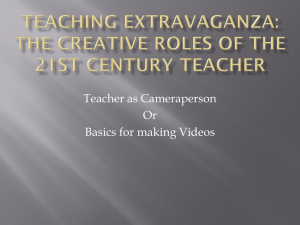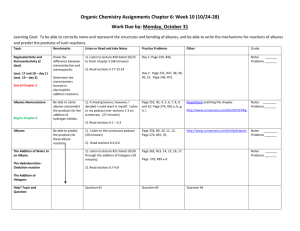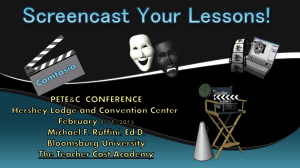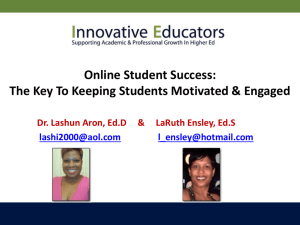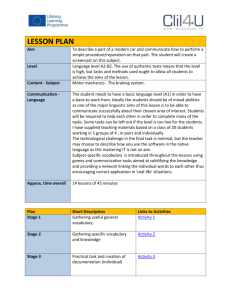DurLT2013 - E-Learning Development Team
advertisement
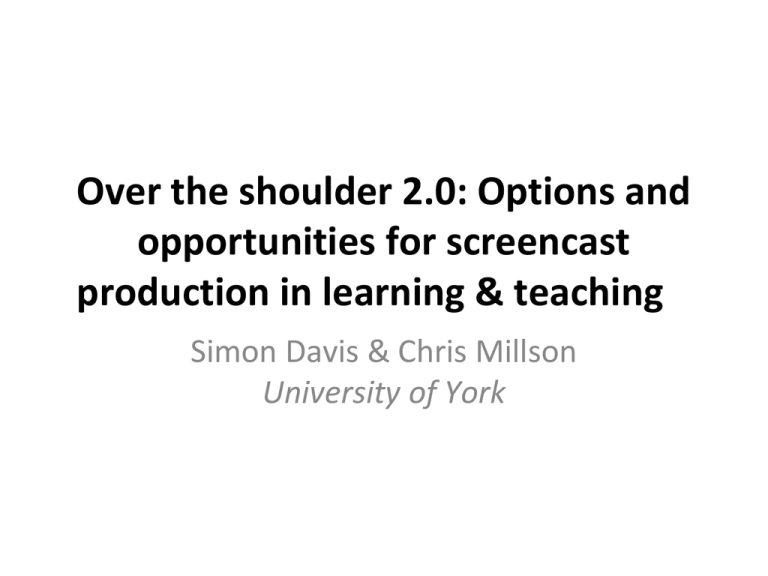
Over the shoulder 2.0: Options and opportunities for screencast production in learning & teaching Simon Davis & Chris Millson University of York Outline • • • • • Overview and benefits of screencasts Applications Production approaches Case studies – feedback and forward Conclusions Screencasting: Overview • Established use in education (~2004 onwards) • Record audio, onscreen activity, webcam (optional) • Potential for reusable, personalised, visual, interactive learning resources • Simple production workflows Screencast @ York #1: Software demos and Tutorials • SPSS statistics package, videos and exercises • ELDT support, videos and step by step guides Screencast @ York #2: Presentations • Distance learning • Realising Opportunities • CAHR • “Flipped classroom” • Interest growing Screencast @ York #3: Worked handwritten examples • Physics – Mathematics 101 • Economics – Introduction to Statistical Theory Screencast @ York #4: Feedforward / feedback • Feedforward – exemplars • CELT; grammar • Chemistry; Transition (what to expect) • Psychology; understanding your feedback • Personalised feedback • CELT • Careers • LFA Production approaches #1: Camtasia Cost: ~£120/user (5-99 users) Storage: ~£7/mo (limited, online) or use own Strengths: Control over editing/quality, can operate entirely offline Weaknesses: Requires desktop application (PC/Mac) - less portable, reported to slow system down (recording intensive software e.g. SPSS), time for post production, complexity Camtasia (playback) Production approaches #2: Screenr Cost: ~£12-180/mo (unlimited users) Storage: online, 250-7,500 recordings Strengths: easy to use, fully online, branding & integration control, analytics Weaknesses: recurring subscription required (although can download files) Notes: Free version (screenr.com) with 5-minute limit Production approaches #3: vGuidance Using screencast-o-matic.com and our own 'vGuidance' interface Cost: Free (unlimited) - ~ £1/month (per account), plus interface development (not essential) Storage: unlimited Strengths: branding/login control, statistics, fully online, no reliance on one system Weaknesses: SOM could disappear (estd. 2006) Use case: Sample: Production approaches #4: Echo360 Cost: Upwards of ~£10k/year plus set-up (Much bigger, hardware-supported system) Strengths: Powerful automated lecture capture for including personal capture, Blackboard integration, account control, local hosting Weaknesses: Only worth the investment if you are considering lecture capture Use case: Institution with a strong commitment to lecture capture - with interest in personal capture Echo360 - playback Comparing production approaches Software Features Ease Reliability of use Quality When to use Camtasia Good for editing Offline, OK Good Full control Creating multi-user guides or where quality is important. Small-medium scale. Screenr Brandable, supported, off-theshelf Online, simple 'Enterprise' product Good Mid/long-term investment in personal capture. vGuidance Brandable Online, simple Good (but no guarantee), requires in-house support Good Ongoing exploration/ development, short trials, small-scale usage. Echo360 Good for editing, brandable, supported, VLE embedding Online, OK 'Enterprise' product Good Large long-term investment in lecture/personal capture. Personalised feedback; production approaches • CELT / Careers / LFA • University starts large review/trials of lecture and personal capture tools • Several Camtasia licenses purchased centrally - some staff used these to try screencasting • Screenr, Screencast-o-matic and other online services tested by Careers for CV reviews • Careers develops generic 'vGuidance' frontend, currently using Screencast-o-matic • University buys Echo360 - now in wide use Personalised feedback; production approaches Camtasia vGuidance Echo 360 • Production time • Access control • Online, integrated workflow • Stability concerns • Workflow • Stable • Supported Personalised feedback; evaluating written FB vs Screencast FB Bill Soden – Centre for English Language Teaching Students read wfb three times+ 9/15 Students viewed sfb three times+ 12/ 15 Q:If you were only able to receive one form of feedback, either written feedback comments or screen cast feedback, which of these two forms of feedback would you choose? 9 chose sfb 4 chose wfb (Kerr & McLaughlin study- three quarters chose sfb) Personalised feedback; SFB strengths • “I think the most obvious advantage is that students can feel engaged as if their tutor is talking to them face to face” • “More straightforward and personal. It's like the tutor is talking to you in person. And the comments are directed to the parts of your article clearly.” • “More memorable because it’s like the teacher is talking to you and giving instructions to you. Sometimes I can't recognize teachers' writing in the written feedback.” Personalised feedback; WFB strengths • Strengths of written feedback • “I think the written feedback is more clear and specific about some small mistakes that I made (like some printing mistakes) while the screen cast tends to be focused mainly on the structure or some other macro aspects. • “You can read it anywhere you like (3) and it's easy to go back to check whereas the screen cast can only be read on your computer. Also, the information is more memorable to visual learners.” • Meeting this with screencast feedback • Ask students to respond to feedback with action points • Provide bullet pointed scripts along with the video Screencast feedback - student responses (year 2 / 4) • Feedback is detailed, easy to follow, more explanatory at various levels (grammar, style, structure, argumentation). • Students feel more confident about how to improve. • Easier to process as you see it happening on screen and hear comments at the same time. • Combination of tools (voice, highlighter, retyping) makes it more memorable. • Grade is justified. • More personal, both from a technical and emotional point of view. • It forces students to pay attention and be more active. • It remains a one way discussion. Screencast feedback - student responses (year 2 / 4) “Most people with a bad mark usually never look at their essay again but the feedback given encourages you to see why your grammar was wrong” “…seeing where I’d gone wrong… meant I actually had to process the feedback, more useful in the long run!” “Best feedback method ever” Screencast feedback – tutor perspective • More enjoyable because it is easier to put your points across. • You can demonstrate the complexity of the reading process. • Students become aware of the time and effort put into giving feedback. • You can talk though a number of aspects at the same time and show how they are related (language, content, structure). • It helps to focus your mind and gain a better awareness of the general quality of students’ work. • It makes you aware of the complexity and potential of effective feedback. • It introduces an emotional dimension. Q&A
